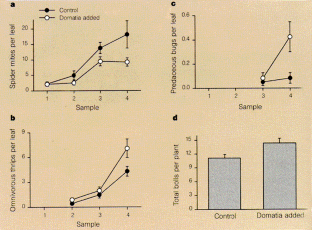Domatia mediate plantarthropod mutualism (original) (raw)
- Scientific Correspondence
- Published: 05 June 1997
Nature volume 387, pages 562–563 (1997)Cite this article
- 1247 Accesses
- 102 Citations
- Metrics details
Abstract
Leaf domatia are small hair-tufts or pockets on the lower surface of leaves, and are exceedingly common among perennial angiosperms, having been reported in 277 plant families and nearly 2,000 species1. Domatia seem to provide refuges for predatory arthropods. Here we show that cotton plants with experimentally added leaf domatia host larger populations of predatory arthropods and smaller populations of herbivorous mites than control plants. Total fruit production was increased by 30 per cent in plants with domatia — the first demonstration that plants benefit from their presence.
This is a preview of subscription content, access via your institution
Access options
Subscribe to this journal
Receive 51 print issues and online access
$199.00 per year
only $3.90 per issue
Buy this article
- Purchase on SpringerLink
- Instant access to full article PDF
Prices may be subject to local taxes which are calculated during checkout
Additional access options:
Figure 1

JACK KELLY CLARK, UNIV. CALIFORNIA
Figure 2: We attached leaf domatia to most newly expanded leaves of 60 plants during the first two months of the growing season at an organic farm near Chowchillaa-c,.

References
- Brouwer, Y. M. & Clifford H. T. Notes Jodrell Lab. 12, 1–33 (1990).
Google Scholar - Walter, D. E. Ann. Rev. Entomol. 41, 101–114 (1996).
Google Scholar - O'Dowd, D. J. & Wilson, M. F. Biol. J. Linn. Soc. 37, 191–238 (1989).
Google Scholar - Walter, D. E. & O'Dowd, D. J. Ecology 73, 1514–1518 (1992).
Google Scholar - Putman, W. L. & Herne, D. H. C. Can. Entomol. 96, 925–943 (1964).
Google Scholar - Fryxell, P. A. The Natural History of the Cotton Tribe (Texas Agric. Mech. Univ. Press, College Station, 1978).
- Integrated Pest Management for Cotton in the Western Region of the United States (Univ. California Div. Agric. Nat. Res. Pub. No. 3305, Regents of the Univ. California, Oakland,1984).
- Trichilo, T. F. & Leigh, T. F. Environ. Entomol. 15, 821–825 (1986).
Google Scholar - Wilson, L. T., Trichilo, P. J. & Gonzalez, D. Environ. Entomol. 20, 849–856 (1991).
Google Scholar - Sadras, V. O. Field Crops Res. 40, 1–18 (1995).
Google Scholar - O'Dowd, D. J. Bull. Entomol. Res. 84, 361–366 (1994).
Google Scholar - Karban, R., English-Loeb, G., Walker, M. A., Thaler, J. Exp. Appl. Acarol. 19, 189–197 (1995).
Google Scholar
Author information
Authors and Affiliations
- Department of Entomology, Center for Population Biology, University of California at Davis, Davis, 95616-8584, California, USA
Anurag A. Agrawal & Richard Karban
Authors
- Anurag A. Agrawal
You can also search for this author inPubMed Google Scholar - Richard Karban
You can also search for this author inPubMed Google Scholar
Rights and permissions
About this article
Cite this article
Agrawal, A., Karban, R. Domatia mediate plantarthropod mutualism.Nature 387, 562–563 (1997). https://doi.org/10.1038/42384
- Issue Date: 05 June 1997
- DOI: https://doi.org/10.1038/42384